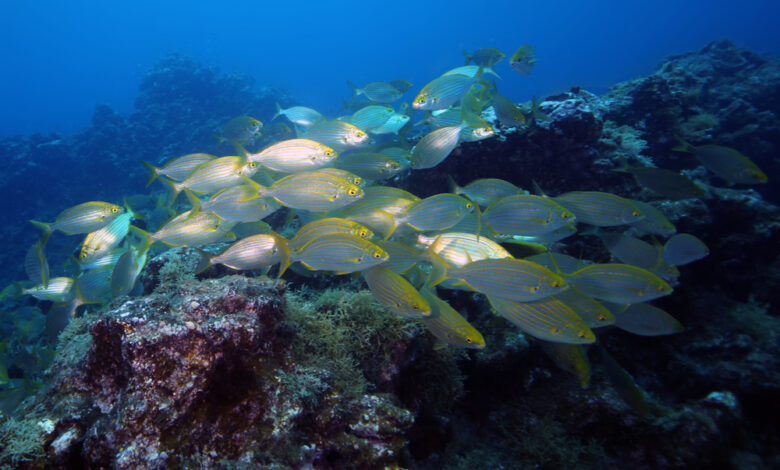A Different Kind of Fishing Trip

Have you ever wondered why so many people like to fish? While many do it for food and a good number do it for sport or relaxation, it turns out more than a few people go fishing for the hallucinations. While psychedelic mushrooms are getting all of the love and medical attention, and while psychedelic toads are getting all of the warnings to avoid licking them, psychedelic fish may be angling for time on the line. Yes, there really are hallucinogenic fish and they’re swimming back into the news. Should The Beatles have been singing about Lucy in the Sky with Dolphins? Should Jefferson Airplane have told us to remember what the dogfish said? Could this be how fish really played a part in so many biblical miracles? Let’s find out if your seafood menu may one day include tripping tilapia and orange roughy sunshine.
“I had never seen one before and after taking a photograph of it I tried to look it up on the internet and called some friends to see if they knew what it was. I put it in the fish box and brought it back for experts to have a look at it. Now I realise what it was and the effects it can have, perhaps I should have taken it into town to sell to some clubbers!”
Recent news about a species of sea bream called salema porgy whose Arabic name means “the fish that makes dreams” comes from IFL Science, but anglers have been fishing for salema porgy or Sarpa salpa since Roman times. More recently, the Telegraph reports that Andy Giles was fishing for lemon sole in 2009 off the coast of Cornwall in the English Channel when he caught an unusual fish with gold stripes that he later identified as a salema porgy or ‘dreamfish’ and wished he would have known what the street value of it was and sold it to some ‘clubbers’ as a party fish instead of getting rid of it.

“A 40-year-old man experienced mild digestive troubles and terrifying visual and auditory hallucinations after eating a specimen of Sarpa salpa in a restaurant. As he had severe behaviour troubles, he was managed in the hospital and recovered 36 h after the meal. He was unable to recall the hallucinatory period.”
It’s too bad Mr. Giles hadn’t read “Hallucinatory Fish Poisoning (Ichthyoallyeinotoxism): Two Case Reports From the Western Mediterranean and Literature Review,” a 2006 article in Clinical Toxicology. The authors were researching two rare occurrences of fish hallucinations – both caused by salema porgy. The second case was a surprised 90-year-old man who ate Sarpa salpa, began having auditory hallucinations two hours later, and reported having more pleasant hallucinations and unpleasant nightmares for three days before they suddenly stopped.
“These are a fairly common fish off Tenerife, Malta and Cyprus but it is very rare to get them this far north. It could be a single fish that was shoaling with a different species but it could be that there are more of them in our waters.”
James Wright, a senior biologist at the National Marine Aquarium in Plymouth, was concerned when Andy Giles caught a sarpa salpa in English waters in 2006. While Brits are experts at preparing fish-and-chips, sarpa salpa apparently requires special care to keep diners from have an unexpected kind of fishing trip. The article in Clinical Toxicology calls the effects of eating ‘dreamfish’ ichthyoallyeinotoxism and refers to it as a rare kind of food poisoning rather than a recreational or medical source of psychedelic trips like Sonora toads or magic mushrooms. Sarpa salpa are found in the East Atlantic, where they swim at a depth of around 230 feet (70 meters) and can grow up to 20 inches in length. However, it is the schools in the Mediterranean that end up being popular dishes in coastal seafood restaurants … after they’ve been properly cleaned and prepared by knowledgeable chefs.
“The fish, and especially its viscera, have been assessed as potentially unsafe by a study conducted on Mediterranean specimens. It is believed that the fish ingests a particular algae or phytoplankton which renders it ichthyoallyeinotoxic.”
As Wikiwand reports, the study linked the psychedelic effects of the sarpa salpa to the fish eating a certain kind of algae or plankton who toxins are harmless to the fish but remains in high concentrations in their heads and internal organs. As reported, eating those parts can result in days of hallucinations. Giving up eating sarpa salpa all together is not a surefire way to avoid the fish trips – the species is part of the genus Kyphosus, and this family of sea chubs includes other psychedelic fish, including Kyphosus fuscus, K. cinerascens and K. vaigiensis. Some marine biologists disagree with the assessment that the toxins come from algae or plankton consumed by the fish, since other fish eat them without passing on hallucinations – a trait seen only in sarpa salpa and its family members. However, there are a few other species of hallucinogenic fish – the Siganus spinus, called “the fish that inebriates,” lives around Reunion Island in the Indian Ocean, is also called the rabbit fish and is white in color. A white rabbit fish? Does Grace Slick know about this? Another hallucinogenic fish is Hawaii’s Yellowstripe goatfish (Mulloides flavolineatus), better known as “the chief of ghosts.”

“It originally became a recreational drug during the Roman Empire in which it was commonly called as “the fish that makes dreams” in Arabic. Anecdotal online trip reports described that “[…] the subjective effects are evident the next day after eating, they had vivid nightmares (I like a giant black dog chasing me through a forest as a kid sometimes after eating some of these usually just fried whole, after being scaled and gutted on each side in butter), more lethargy than any psychedelia and with excessive consumption (usually with beer) people often have slurred speech and slow/reduced reflexes.”
Before you book a fishing trip to the Mediterranean to catch and lick some dreamfish, a study in Frontiers in Psychiatry warns that even the ancient Romans were cautious when eating “the fish that makes dreams” and that many reports of their effects are anecdotal and possibly enhanced with alcohol. Nonetheless, if you decide to try it, think about what Jefferson Airplane might have sang had they just finished a dinner of sarpa salpa:
“Remember what the dogfish said
Don’t eat the head.”




